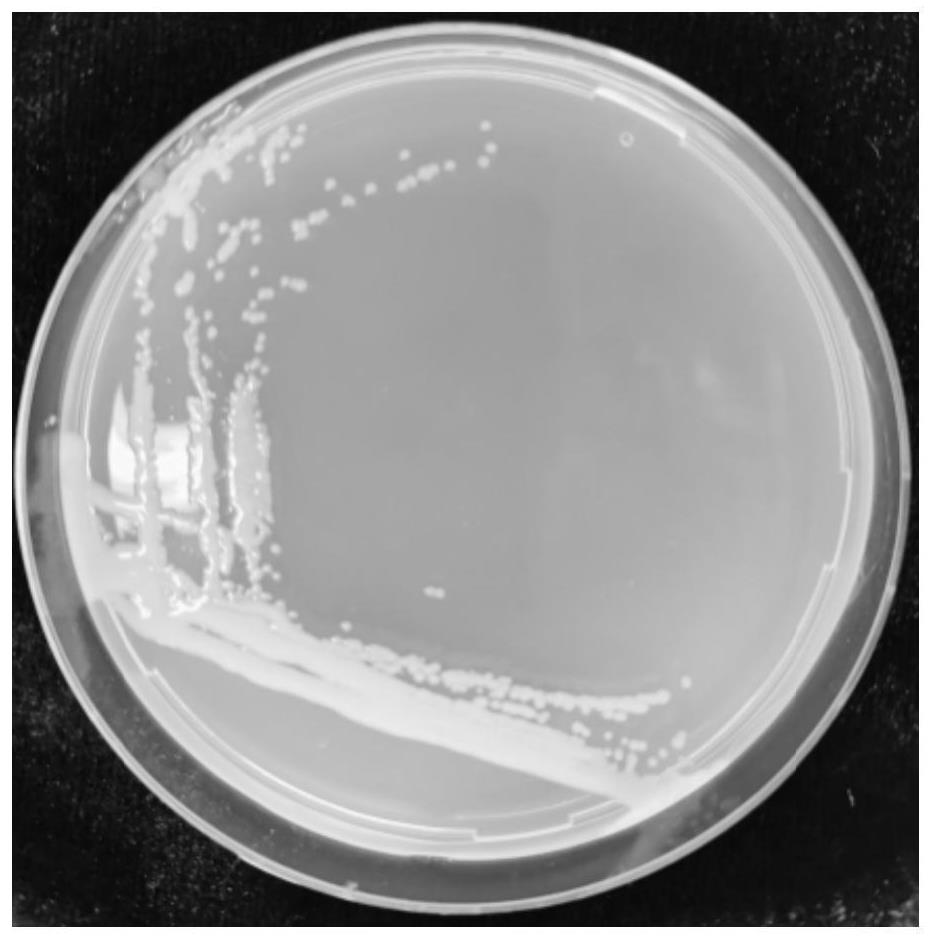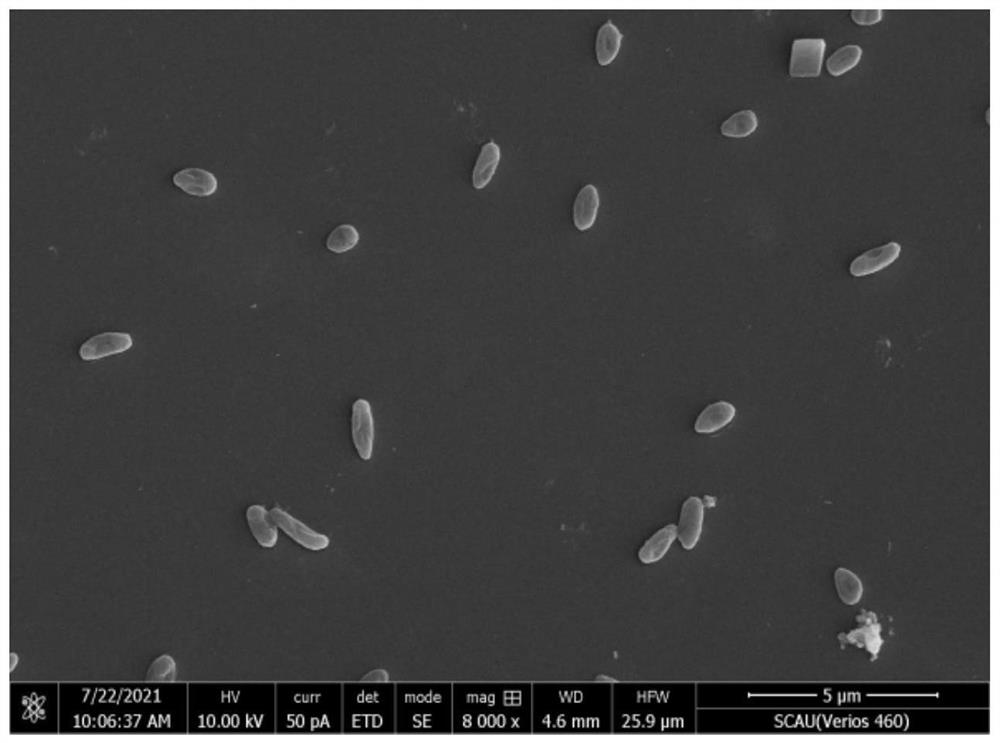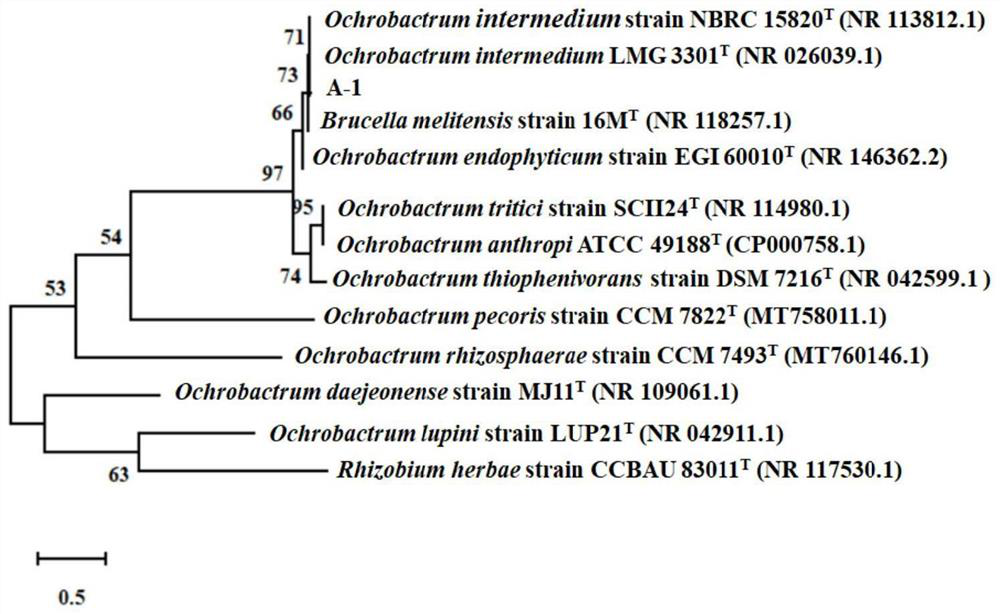Human ochrobactrum capable of efficiently degrading glyphosate and application of human ochrobactrum
A technology of Bacillus hominis and glyphosate, which is applied to Bacillus hominis hominis for efficiently degrading glyphosate and its application field, and achieves the effect of great application value
- Summary
- Abstract
- Description
- Claims
- Application Information
AI Technical Summary
Problems solved by technology
Method used
Image
Examples
Embodiment 1
[0042] Example 1 Isolation and identification of Ochrobactrum anthropi A-1
[0043] 1. Screening and isolation of glyphosate-degrading strains
[0044]Activated sludge was collected from the wastewater treatment tank of a pesticide factory in Huadu District, Guangzhou, and 5 g of activated sludge sample was weighed and added to 50 mL of the above-mentioned MSM liquid medium containing glyphosate (50 mg / L). After culturing for 7 days at 30°C and 200 r / min, 2% of the previous round of culture medium was inoculated into new MSM medium each time, and the mass concentration of pesticides was increased from 50 mg / L to 100 mg / L, 200 mg / L, 400mg / L, 800mg / L for continuous enrichment culture. Then, the transferred culture medium was diluted 4 times and spread on MSM solid plates containing 400 and 800 mg / L glyphosate, and cultured upside down at 30°C for 2 d. After a single colony grew on the plate, pick a single colony on LB solid medium for multiple streak purification, and then use...
Embodiment 2
[0060] Example 2 Experiment on the degradation effect of Bacillus hominis A-1 on glyphosate
[0061] 1. Experimental method
[0062] (1) Preparation of seed liquid: Bacillus hominis A-1 purified in Example 1 was inserted into LB liquid medium containing 5 mL, activated and cultured to logarithmic phase overnight, centrifuged at 4000 rpm, and the cells were treated with sterile physiological The cells were washed twice with saline (0.9% NaCl) and used as inoculum. Resuspend the bacteria with sterile saline to adjust the OD of the bacteria 600 The value is 1.0.
[0063] (2) Determination of degradation performance: 1 mL of the above bacterial solution was inoculated into 50 mL of MSM culture solution containing glyphosate (400 mg / L), and no inoculation was used as a control, and each group was repeated three times. Incubate at 30°C and 200rpm for 72h in a constant temperature shaker, take samples every 12h, and use a UV-Vis spectrophotometer to measure the growth of P. homini...
Embodiment 3
[0084] Example 3 Effects of different culture conditions on the degradation of glyphosate by Bacillus hominis A-1
[0085] 1. Experimental method
[0086] The Bacillus pallidum A-1 obtained in Example 1 was activated in liquid LB medium, cultured at 30° C. in a constant temperature shaker at 200 r / min in the dark for 12 h, and centrifuged at 8000 r / min for 10 min to collect the bacteria, and use sterile physiological After washing 3 times with saline, resuspend and adjust the OD of the bacterial suspension 600 A value of 1.0 is reserved for later use. Initial pH (5.0, 6.0, 7.0, 8.0 and 9.0), inoculum size (1%, 2%, 3%, 4% and 5%), temperature (20°C, 25°C, 30°C, 35°C and 40°C) were investigated separately ℃), initial concentration of glyphosate (25, 50, 100, 200, 400 and 800 mg / L) on the degradation of glyphosate by Bacillus hominis A-1. Subsequently, samples were taken every 12 hours to detect the concentration of residual glyphosate. Taking no inoculation as a control, eac...
PUM
 Login to View More
Login to View More Abstract
Description
Claims
Application Information
 Login to View More
Login to View More - R&D
- Intellectual Property
- Life Sciences
- Materials
- Tech Scout
- Unparalleled Data Quality
- Higher Quality Content
- 60% Fewer Hallucinations
Browse by: Latest US Patents, China's latest patents, Technical Efficacy Thesaurus, Application Domain, Technology Topic, Popular Technical Reports.
© 2025 PatSnap. All rights reserved.Legal|Privacy policy|Modern Slavery Act Transparency Statement|Sitemap|About US| Contact US: help@patsnap.com



